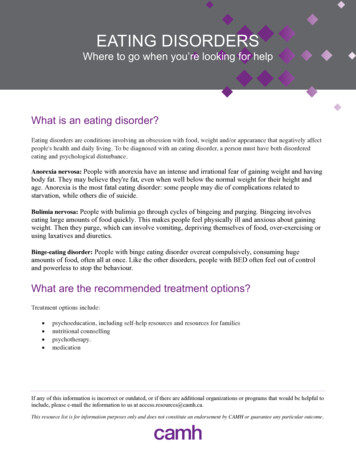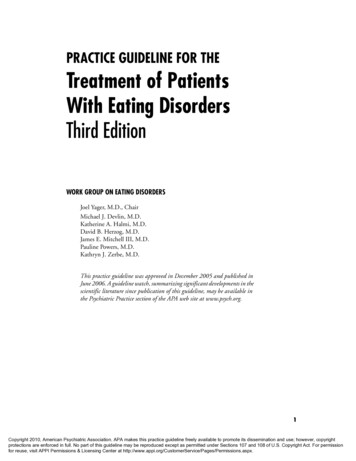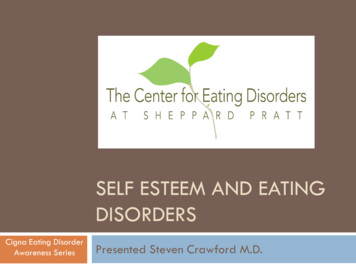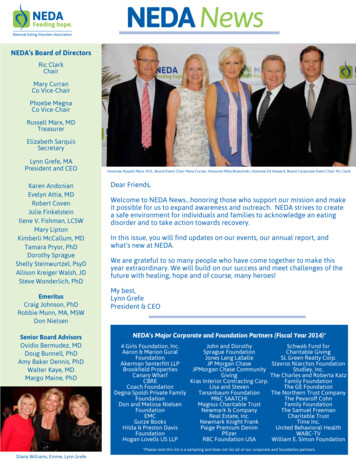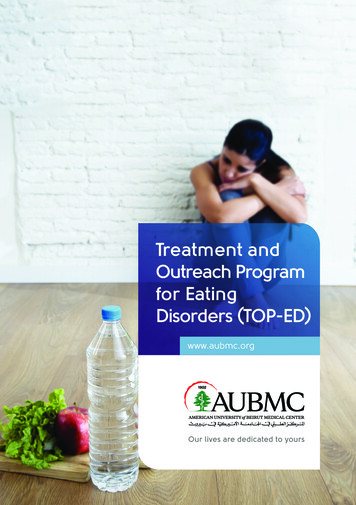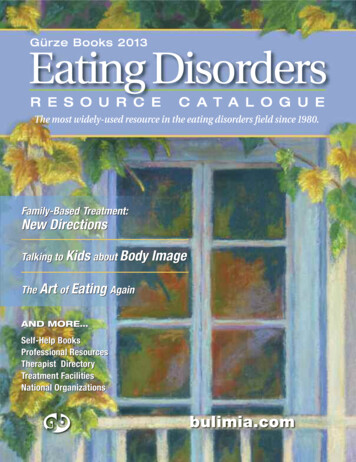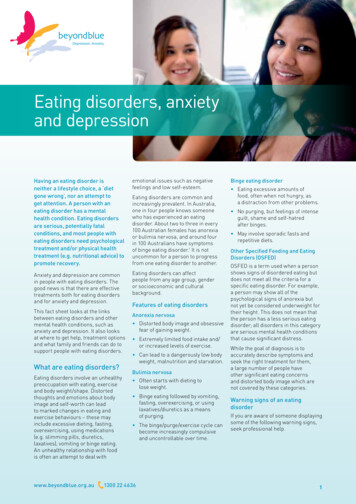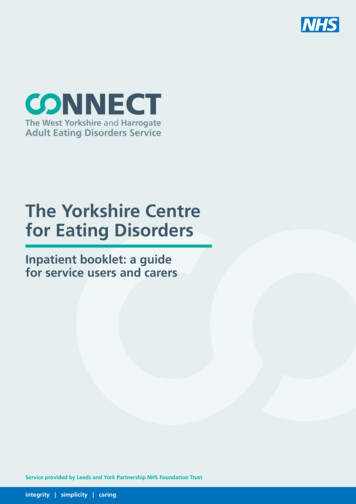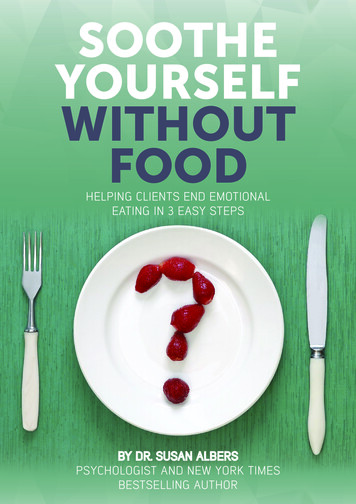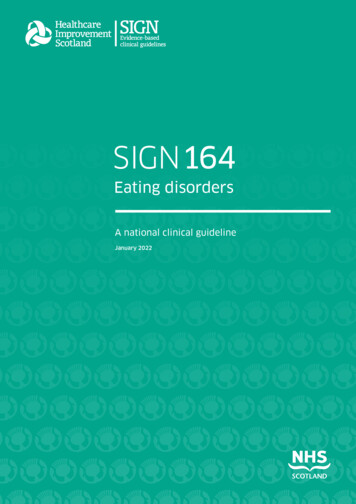
Transcription
SIGN164Eating disordersA national clinical guidelineJanuary 2022
Key to evidence statements and recommendationsLevels of evidence1 High-quality meta-analyses, systematic reviews of RCTs, or RCTs with a very low risk of bias1 Well-conducted meta-analyses, systematic reviews, or RCTs with a low risk of bias1–Meta-analyses, systematic reviews, or RCTs with a high risk of bias2 High-quality systematic reviews of case-control or cohort studies High-quality case-control or cohort studies with a very low risk of confounding or bias and a highprobability that the relationship is causal2 Well-conducted case-control or cohort studies with a low risk of confounding or bias and a moderateprobability that the relationship is causal2– Case-control or cohort studies with a high risk of confounding or bias and a significant risk that therelationship is not causal3Non-analytic studies, eg case reports, case series4Expert opinionRecommendationsSome recommendations can be made with more certainty than others. The wording used in the recommendationsin this guideline denotes the certainty with which the recommendation is made (the ‘strength’ of therecommendation).The ‘strength’ of a recommendation takes into account the quality (level) of the evidence. Although higher-qualityevidence is more likely to be associated with strong recommendations than lower-quality evidence, a particularlevel of quality does not automatically lead to a particular strength of recommendation.Other factors that are taken into account when forming recommendations include: relevance to the NHS in Scotland;applicability of published evidence to the target population; consistency of the body of evidence; and the balanceof benefits and harms of the options.R For ‘strong’ recommendations on interventions that ‘should’ be used, the guideline development group isconfident that, for the vast majority of people, the intervention (or interventions) will do more good thanharm. For ‘strong’ recommendations on interventions that ‘should not’ be used, the guideline developmentgroup is confident that, for the vast majority of people, the intervention (or interventions) will do moreharm than good.R For ‘conditional’ recommendations on interventions that should be ‘considered’, the guideline developmentgroup is confident that the intervention will do more good than harm for most patients. The choice ofintervention is therefore more likely to vary depending on a person’s values and preferences, and so thehealthcare professional should spend more time discussing the options with the patient.Good-practice points Recommended best practice based on the clinical experience of the guideline development group.NICE has accredited the process used by Scottish Intercollegiate Guidelines Network toproduce clinical guidelines. The accreditation term is valid until 31 March 2025 and isapplicable to guidance produced using the processes described in SIGN 50: a guidelinedeveloper’s handbook, 2019 edition (https://www.sign.ac.uk/assets/sign50 2019.pdf).More information on accreditation can be viewed at www.nice.org.uk/accreditationHealthcare Improvement Scotland (HIS) is committed to equality and diversity and assesses all its publications forlikely impact on the six equality groups defined by age, disability, gender, race, religion/belief and sexual orientation.SIGN guidelines are produced using a standard methodology that has been equality impact assessed to ensure thatthese equality aims are addressed in every guideline. This methodology is set out in the current version of SIGN 50,our guideline manual, which can be found at www.sign.ac.uk/sign-50.html. The EQIA assessment of the manual canbe seen at www.sign.ac.uk/assets/sign50eqia.pdf. The full report in paper form and/or alternative format is availableon request from the Healthcare Improvement Scotland Equality and Diversity Officer.Every care is taken to ensure that this publication is correct in every detail at the time of publication. However,in the event of errors or omissions corrections will be published in the web version of this document, which is thedefinitive version at all times. This version can be found on our website www.sign.ac.uk
Scottish Intercollegiate Guidelines NetworkEating disordersA national clinical guidelineJanuary 2022
Scottish Intercollegiate Guidelines NetworkGyle Square, 1 South Gyle CrescentEdinburgh EH12 9EBwww.sign.ac.ukFirst published January 2022978-1-909103-89-4Citation textScottish Intercollegiate Guidelines Network (SIGN).Eating disorders 2022. (SIGN publication no. 164). [January 2022].Available from URL: http://www.sign.ac.ukThis document is licensed under the Creative Commons Attribution-Noncommercial-NoDerivatives4.0 International Licence. This allows for the copy and redistribution of this document as long as SIGNis fully acknowledged and given credit. The material must not be remixed, transformed or built uponin any way. To view a copy of this licence, visit https://creativecommons.org/licenses/by-nc-nd/4.0/
Contents1Introduction11.1The need for a guideline11.2Remit of the guideline21.3Statement of intent42Key recommendations72.1Early interventions72.2Support for family and carers72.3Achieving and maintaining recovery72.4Psychological therapies72.5Type 1 diabetes82.6Training for healthcare professionals83Framing the journey of care93.1Early intervention93.2Support for family and carers93.3Achieving and maintaining recovery103.4Using the Mental Health Act to support care143.5Transition154Therapeutic interventions174.1Treatment fidelity174.2Delivering therapies remotely175Children and adolescents with anorexia nervosa185.1Psychological therapies185.2Pharmacological therapies196Children and adolescents with bulimia nervosa206.1Psychological therapies206.2Pharmacological therapies207Children and adolescents with binge eating disorder217.1Psychological therapies217.2Pharmacological therapies218Children, adolescents and adults with type 1 diabetes228.1Psychological therapies228.2Pharmacological therapies239Adults with anorexia nervosa249.1First-line psychological therapy249.2Second-line psychological therapies259.3Other psychological therapies269.4Recommendations for psychological therapies279.5Pharmacological therapies27
10Adults with bulimia nervosa2910.1First-line psychological therapies2910.2Second-line psychological therapies3010.3Recommendations for psychological therapies3110.4Pharmacological therapies3111Adults with binge eating disorder3311.1First-line psychological therapies3311.2Second-line psychological therapies3411.3Recommendations for psychological therapies3511.4Pharmacological therapies3612Bone mineral density3813Severe and enduring eating disorders4014Pregnancy and postnatal care4314.1Eating disorders during pregnancy and the postnatal period4314.2Comorbid anxiety and depression4414.3Medication use4414.4Dietary intake4414.5Obstetric outcomes4514.6Infant outcomes4614.7Training and education4615Needs of diverse communities4715.1Men with eating disorders4715.2LGBTQ people with eating disorders4715.3Eating disorders in people from minority ethnic groups4815.4Recommendations4816Provision of information4916.1Publications from SIGN4916.2Sources of further information4916.3Checklist for provision of information5117Implementing the guideline5217.1Implementation strategy5217.2Resource implications of key recommendations5217.3Auditing current practice5218The evidence base5318.1Systematic literature review5318.2Recommendations for research5418.3Review and updating5519Development of the guideline5619.1Introduction5619.2The guideline development group5619.3Consultation and peer review57Abbreviations60Annexes63References72
1 Introduction1Introduction11Introduction1.1The need for a guidelineEating disorders are characterised by preoccupation with weight, shape and calorie balance. Theterm eating disorders may seem misleading: not all disorders of eating are ‘eating disorders’ andwhen an eating disorder diagnosis is made it implies that more than eating behaviour is disordered.Purging, overexercise and preoccupation with body image cause psychosocial and physical harm.The guideline includes evidence for the management of people with anorexia nervosa (AN), bulimianervosa (BN), and binge eating disorders (BED).Eating disorders typically begin in early to mid-adolescence, but can emerge at any age.1-3 Lifetimeprevalence of AN in the general population in Western countries is about 1% in women and 0.5%in men.4 Prevalence of eating disorders in teenage girls is as high as 12%, with about 1% meetingcriteria for AN, the disorder with the highest mortality of any psychiatric disorder.4 The trueprevalence may be underestimated as it has been found that half of those who meet diagnosticcriteria in the community do not access treatment.4 Anorexia nervosa and BN are more commonamong female than male individuals5 and there are higher rates of disordered eating among peoplewho identify as lesbian, gay, bisexual, transgender, queer (LGBTQ ), or non-binary, particularly intransgender people.6 A high prevalence of eating disorders associated with people from minorityethnic groups was reported in a study of a community in South East London.7 Other UK-basedstudies have reported lower referral rates, and that people with minority ethnic backgrounds areless likely to seek treatment than white people.8,9Adolescents have higher rates of full recovery and lower mortality than adults (mean mortality2% vs 5%).10 With treatment, around 50% of people with AN achieve full functional recovery.10The cycle of treatment, recovery and relapse can cause severe disruption to education, employment,professional development and lifetime earnings.11 Caring for someone with a severe eating disordercan pose psychosocial and financial burdens on families. Within mental health services in 2015,the average annual financial cost of treating someone with an eating disorder was 8,850, butexceeded 100,000 when combined with treatment of physical consequences.11Earlier Scottish guidance on the management of eating disorders lead to an expansion in theprovision and quality of services in NHSScotland, however the guidance is now out of date.12In 2020 the Mental Welfare Commission (MWC) for Scotland undertook a themed visit of eatingdisorder services and identified inequalities in the provision of services, including access topsychological therapies, and gaps in care during transition between services.13 It also showedthere is wide variation in the organisation of services for people with eating disorders acrossScotland. One of the recommendations from the report was for SIGN to produce a guideline onthe efficacy of treatments for people with eating disorders. The MWC report was followed bya Scottish Government-commissioned national review of eating disorder services, which waspublished in June 2021.14 The report resulted in a number of recommendations to improve care,including implementing the recommendations of this guideline. An implementation group has beenestablished by Scottish Government to take forward the recommendations in the report.This guideline draws on an evidence base, interpreted in the context of the needs of Scottishservice users and incorporating their lived experience. Where appropriate, quantitative evidencehas been supplemented with the findings from qualitative research studies. Recommendations aremade not only about service provision but also about ways to address the lack of agreed outcomemeasures and associated data collection nationally, and to direct research, paving the way for agrowth in evidence and good practice.1
Eating disorders1.1.1Patient and carer perspectivePatients and carers may have different perspectives on healthcare processes and outcomes fromthose of healthcare professionals. The involvement of patients and carers in guideline developmentis therefore important to ensure that guidelines reflect their needs and concerns and addressissues that matter to them.As part of the guideline development process, third-sector organisations were invited to submitfeedback on the views of patients, carers and service users on the guideline topic for considerationby the guideline development group. People with lived experience of eating disorders (aged 16–25)and people who have a support/caring role were recruited through Beat and the Scottish EatingDisorders Interest Group (SEDIG) to attend an interactive group session to discuss their priorities forimprovements in care. Their views and preferences were then considered by the guideline group.Common issues raised by patient and carer groups and through research include: sing weight as the sole measure of illness severity and need for treatment, or of recovery,Uwas seen as unhelpful, potentially preventing early access to treatment. It may even providea perverse incentive to lose more weight. A preference for treatment to focus on emotional and self-image concerns rather than anexclusive focus on weight gain and physical health. wish for patients to have more choice about the type of treatment they receive rather thanAthis being dictated by local protocols. need for better support during transitions between child and adolescent mental health serviceA(CAMHS) and adult services, or between health boards, for example when moving away fromhome to university. The impact comorbidities can have on eating disorders and vice versa. he need to adapt services and treatments to be more inclusive of people from minority ethnicTbackgrounds, men, people with LGBTQ identities and those who are neurodivergent. The need for awareness and treatment of eating disorders during pregnancy and parenthood. concern that while attention is paid to eating behaviour and purging behaviour theAmanagement of healthy exercise levels is often neglected. he need for follow-up support by primary care, social services and the third sector afterTdischarge from NHS eating disorder services. This includes attention to the physical problemsresulting from an eating disorder, such as fertility, and dental or bone health. It may also involvesignposting to self-help materials and peer-support groups. he importance of a positive and hopeful attitude that individuals and carers can makeTmeaningful improvements to their quality of life.Information points, to support informed discussion with patients, their families and carers, aredenoted throughout the guideline with the symboland carers is in section 16.1.2Remit of the guideline1.2.1Overall objectives. Further information for patients, familyThis guideline provides recommendations based on current evidence for best practice in themanagement of people with eating disorders of all ages and gender groups, in any health or socialcare setting. Eating disorders covered are anorexia nervosa, bulimia nervosa and binge eatingdisorder. Advice for treating people with eating disorders which do not entirely meet formaldiagnostic criteria is to follow guidance for the diagnosis most aligned with their difficulties.This guideline also includes management of ‘eating disordered’ psychopathology occurring in thecontext of type 1 diabetes mellitus.2
1 IntroductionThe feeding disorder avoidant/restrictive food intake disorder (ARFID) was included in theevidence review as people with ARFID can be seen in a range of services, including eating disorderservices. However, no evidence was found to support advice on management of patients with thiscondition. Similarly, no robust evidence was found on the management of autistic people witheating disorders. Expert advice on autism and eating disorders, including ARFID, is available inthe Pathway for Eating disorders and Autism developed from Clinical Experience (PEACE) (www.peacepathway.org). Advice on the assessment and management of autistic spectrum disorder canbe found in SIGN 145: Assessment, diagnosis and interventions for autism spectrum disorders.15A holistic and individualised approach to care is required. The guideline focuses on evidence-basedtherapies. Other therapies, such as arts therapies, dietetics, occupational therapy, physiotherapyand speech and language therapies, play an integral part in the management of patients with eatingdisorders, but a lack of robust research prevented their inclusion in an evidence-based guideline.The remit excludes the management of obesity in the absence of a diagnosable eating disorder,and prevention of eating disorders, as both of these are substantial topics which warrant separateguidelines in their own right.A mixed methods approach, using quantitative and qualitative evidence was applied where it wasconsidered that qualitative studies would provide better insight into the needs of the populationaddressed in the key question (see Annex 1).1.2.2Comorbidities to consider when managing patients with eating disordersCommon comorbidities and coexisting health issues which have been considered when reviewingthe evidence for this guideline are: anxiety disorders autism spectrum disorder (ASD) (and autistic spectrum which is not experienced as a disorderbut as a variant of normal mental health) complex trauma personality disorders (PD) depressive disorders obsessive-compulsive disorder (OCD) mental health conditions of pregnancy and the postnatal period post-traumatic stress disorder (PTSD) psychotic conditions including schizophrenia and bipolar psychoses substance and/or alcohol misuse type 1 diabetes mellitus other physical illnesses, particularly those where symptoms and signs affect body weightor where treatment might affect body weight, eg cystic fibrosis, thyroid abnormalities orinflammatory bowel disease.1.2.3Definitions and treatment outcomesEvolving considerations about the nature and classification of eating disorders affect the precisionwith which treatments can be researched. In recent years major changes have been made to theclassification of eating disorders in the Diagnostic and Statistical Manual of Mental Disorders (DSM5) and the International Classification of Diseases (ICD 11).16,17 Most treatments involve biological,behavioural and psychosocial elements, making it hard to attribute outcomes. Clinicians recognisethat failure to precisely meet listed criteria does not automatically mean that patients’ symptomscould not respond to a treatment.3
Eating disordersScottish eating disorders services specialise in those disorders sharing the core psychopathology ofpreoccupation with weight and shape. Thresholds for referral depend more on service availabilitythan on diagnostic criteria, and clinicians are not obliged to ration care to those meeting formalcriteria. Such criteria are commonly used to delineate research cohorts, however. DSM-5 and ICD11 criteria discriminate between anorexia nervosa and bulimia nervosa on the basis of weight.16,17The hallmark of AN is significant weight loss, whilst those who are not underweight are diagnosedas having BN if they purge (induce vomiting or use laxatives) or exercise excessively after bingeing,but BED if they binge without purging.The term diabulimia (not recognised in official diagnostic criteria) implies that causing calories tobe excreted in the form of glycosuria and high blood glucose levels is analogous to purging. Peoplewith diabetes lose weight easily by omitting insulin rather than by restricting diet or energy deficit.Thirty to forty percent of young people with diabetes omit or reduce insulin with the intention oflosing weight.18 Longitudinal studies suggest an increase in eating disorders in people with type1 diabetes mellitus.19There is disagreement about what constitutes recovery from eating disorders, with consequentvariation in outcome figures. Qualitative meta-analysis finds that recovered individuals value selfacceptance, autonomy and interpersonal relationships as much as reduced ED symptomatology.20The evidence cited tends to use the expression ‘child’ to refer to prepubertal children and ‘youngpeople’ to indicate either adolescents under the age of 18 or people in their teens and 20s. Somestudies used mixed samples of people under and over 18 years of age, therefore use of theseexpressions in the guideline is colloquial rather than implying strict age cut offs.Much of the research has been based in inpatient settings. Where this guideline refers to inpatientsthis indicates residential treatment in a unit that specialises in the management of eating disorders.Where the patient is treated in an acute medical hospital, a diabetic ward or a general psychiatricunit this is specified.1.2.4Target users of the guidelineThis guideline will be of interest to primary, secondary and tertiary healthcare professionalsincluding clinical psychologists, dietitians, endocrinologists, gastroenterologists, general practitioners(GPs), health visitors, nurses, art therapists, occupational therapists, physiotherapists, perinatalmental health clinicians, psychiatrists, social workers, speech and language therapists, teachersand university staff, as well as patients and their families and carers.1.2.5Patient and carer versionsPatient and carer versions of this guideline are available from the SIGN website, www.sign.ac.uk1.2.6Equality impact assessmentAn equality impact assessment for the development of this guideline is available in the supportingmaterial section for this guideline on the SIGN website, www.sign.ac.uk1.3Statement of intentThis guideline is not intended to be construed or to serve as a standard of care. Standards of careare determined on the basis of all clinical data available for an individual case and are subject tochange as scientific knowledge and technology advance and patterns of care evolve. Adherenceto guideline recommendations will not ensure a successful outcome in every case, nor should theybe construed as including all proper methods of care or excluding other acceptable methods ofcare aimed at the same results.4
1 IntroductionThe ultimate judgement must be made by the appropriate healthcare professional(s) responsiblefor clinical decisions regarding a particular clinical procedure or treatment plan. This judgementshould only be arrived at through a process of shared decision making with the patient, coveringthe diagnostic and treatment choices available. It is advised, however, that significant departuresfrom the national guideline or any local guidelines derived from it should be documented in thepatient’s medical records at the time the relevant decision is taken.1.3.1Influence of financial and other interestsIt has been recognised that financial or academic interests may have an influence on theinterpretation of evidence from clinical studies.It is not possible to completely eliminate any possible bias from these sources, nor even toquantify the degree of bias with any certainty. SIGN requires that all those involved in the workof guideline development should declare all financial and academic interests, whether direct orindirect, annually for as long as they are actively working with the organisation. By being explicitabout the influences to which contributors are subjected, SIGN acknowledges the risk of bias andmakes it possible for guideline users or reviewers to assess for themselves how likely it is that theconclusions and guideline recommendations are based on a biased interpretation of the evidence.Signed copies of declaration of interests forms are retained by the SIGN Executive and a registerof interests is available in the supporting material section for this guideline at www.sign.ac.uk1.3.2Prescribing of licenced medicines outwith their marketing authorisationRecommendations within this guideline are based on the best clinical evidence. Somerecommendations may be for medicines prescribed outwith the marketing authorisation (MA),also known as product licence. This is known as ‘off-label’ use.With the exception of fluoxetine, which is licensed for use in patients with bulimia nervosa,medications used to treat patients with eating disorders are ‘off label’.Medicines may be prescribed ‘off label’ in the following circumstances: for an indication not specified within the marketing authorisation for administration via a different route for administration of a different dose for a different patient population.An unlicensed medicine is a medicine which does not have MA for medicinal use in humans.Generally ‘off-label’ prescribing of medicines becomes necessary if the clinical need cannot bemet by licensed medicines within the marketing authorisation. Such use should be supported byappropriate evidence and experience.21“Prescribing medicines outside the conditions of their marketing authorisation alters (and probablyincreases) the prescribers’ professional responsibility and potential liability”.21The General Medical Council (GMC) recommends that when prescribing a medicine ‘off label’,doctors should:22 Be satisfied that there is no suitably licensed medicine that will meet the patient’s need. e satisfied that there is sufficient evidence or experience of using the medicine to show itsBsafety and efficacy ake responsibility for prescribing the medicine and for overseeing the patient’s care, includingTmonitoring the effects of the medicine, and any follow-up treatment, or ensure that arrangementsare made for another suitable doctor to do so. ake a clear, accurate and legible record of all medicines prescribed and, when not followingMcommon practice, the reasons for prescribing an unlicensed medicine.5
Eating disordersNon-medical prescribers should ensure that they are familiar with the legislative framework andtheir own professional prescribing standards.Prior to any prescribing, the licensing status of a medication should be checked in the summaryof product characteristics (www.medicines.org.uk). The prescriber must be competent, operatewithin the professional code of ethics of their statutory bodies and the prescribing practices oftheir employers.23Prescribers routinely take age, gender and weight into account when prescribing, but the effectof medications on a starved adult body may not be same as on the body of a healthy child of thesame weight.24 Prescribers should also be aware of the potential for unconscious bias, and shouldconsider possible pharmacogenetics differences in patients of different ethnic groups.6
2 Key recommendations2Key recommendationsThe following recommendations were highlighted by the guideline development group as the keyclinical recommendations that should be prioritised for implementation.2.1Early interventionR A pilot of an additional FREED service to complement existing eating disorders servicesmay be considered. This would offer early intervention to young adults aged 16–25 witheating disorders of less than three years’ duration.2.2Support for family and carersR Formal carer support should be offered to all carers. This could draw on materials fromExpert Carers Helping Others self help or Collaborative Carer Workshops.2.3Achieving and maintaining recoveryR Refeeding to an optimised healthy weight (taking the patient’s ethnicity and sex intoconsideration) should be offered routinely to all patients with anorexia nervosa, both as alife saving measure and also as an adjunct to achieving an optimised weight and to reducerelapse.2.4Psychological therapiesRThe following psychological therapies are recommended: hildren and adolescents with anorexia nervosa should be offered family-basedCtreatment. dolescents with bulimia nervosa should be offered cognitive behavioural therapy orAfamily-based treatment. dolescents with binge eating disorder could be offered cognitive behavioural therapy,Ainterpersonal psychotherapy or family-based interventions.R Systemic family therapy and augmentative family-based treatment approaches could beconsidered for children and adolescents with anorexia nervosa where there are additionalfeatures such as severe OCD or high levels of expressed emotion.R Adolescents with anorexia nervosa could be offered enhanced cognitive behavioural therapy(CBT-E as per Fairburn’s model), at a dosage of 20–40 weekly sessions, or other forms oftransdiagnostic CBT for eating disorders.RThe following therapies should be used as first-line therapies for adults. hose with anorexia nervosa should be offered enhanced cognitive behavioural therapyTor other forms of CBT. hose with bulimia nervosa should be offered cognitive behavioural therapy, preferablyTspecially adapted CBT-E or CBT-BN. hose with binge eating disorder should be considered for cognitive behavioural therapyTor interpersonal psychotherapy.7
Eating disordersR If cognitive behavioural therapy is ineffective, unsuitable or unacceptable for adults withanorexia nervosa, other therapeutic approaches could be considered, such as interpersonalpsychotherapy, the Maudsley Model of Anorexia Treatment, Specialist Supportive ClinicalManagement, or focal psychodynamic therapy.R If cognitive behavioural therapy is ineffective, unsuitable or unacceptable, in adults withbulimia nervosa, other treatment options could be considered, such as, interpersonal therapy,integrative cognitive-affective therapy, or schema therapy. Mentalisation-based therapymay be considered if the patient has comorbid borderline personality disorder.2.5Type 1 diabetesR Integrated intensive specialist care with the combined involvement of diabetes professionalsand mental health professionals with experience in managing eating disorders isrecommended to support people with type 1 diabetes and an eating disorder or compulsiveinsulin omission for weight control. Some patients may benefit from a specialist inpatienteating disorders service.R Healthcare professionals should consider managing control of insulin administrationalongside psychological interventions to address motivation, distress tolerance and to buildtrusting relationships with profes
nervosa (BN), and binge eating disorders (BED). Eating disorders typically begin in early to mid-adolescence, but can emerge at any age. 1-3. Lifetime prevalence of AN in the general population in Western countries is about 1% in women and 0.5% in men. 4. Prevalence of eating disorders in teenage girls is as high as 12%, with about 1% meeting
